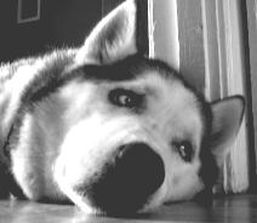
Burns
The majority of burn wounds in dogs occur in the home and are categorized as thermal (heat), chemical and electrical.
Superficial thermal burns can be treated by immersion of the affected skin in cold water or by applying an ice pack. Then remove any hair or debris from the burn wound and gently pat dry. Do not use oil-based medications on a burn wound. A non-stick telfa pad can then be applied followed by a light bandage to hold it in place. If the burn wound becomes infected or is not healing, veterinary care is needed.
Deep thermal burns extend below the surface of the skin and require immediate veterinary attention. Place a cloth loosely over the burn area (Do not rinse with water or place any medications in the wound) and then head to your emergency vet immediately. These burn wounds are serious, very painful and some dogs may even go into shock.
Electrical burns are usually the result of a dog biting into an electrical wire. The burns are seen on the lips and tongue (where the dog bit the cord) but the dog’s entire body received an electrical shock. If you see your dog bite an electrical cord, do not touch the dog or try to pull the cord from its mouth as you may get shocked. First pull the plug from the outlet before doing anything else. If your dog is unconscious, then firstly check for breathing and a heartbeat or pulse. If breathing or the heart has stopped you may need to perform CPR. After any electrical burn or shock, even if your dog seems fine, seek immediate veterinary care.
Chemical burns (acid or alkali compounds) may occur on the surface of the body or may be ingested. Rinsing the chemical off with water should be done as soon as possible. However, if you know the compound is an acid, you can rinse the area with baking soda dissolved in water. If the compound is alkaline, then vinegar and water may be used. If your dog ingested the compound, check the container to see if there is an antidote and seek veterinary care immediately.
The majority of burn wounds in dogs occur in the home and are categorized as thermal (heat), chemical and electrical.
Superficial thermal burns can be treated by immersion of the affected skin in cold water or by applying an ice pack. Then remove any hair or debris from the burn wound and gently pat dry. Do not use oil-based medications on a burn wound. A non-stick telfa pad can then be applied followed by a light bandage to hold it in place. If the burn wound becomes infected or is not healing, veterinary care is needed.
Deep thermal burns extend below the surface of the skin and require immediate veterinary attention. Place a cloth loosely over the burn area (Do not rinse with water or place any medications in the wound) and then head to your emergency vet immediately. These burn wounds are serious, very painful and some dogs may even go into shock.
Electrical burns are usually the result of a dog biting into an electrical wire. The burns are seen on the lips and tongue (where the dog bit the cord) but the dog’s entire body received an electrical shock. If you see your dog bite an electrical cord, do not touch the dog or try to pull the cord from its mouth as you may get shocked. First pull the plug from the outlet before doing anything else. If your dog is unconscious, then firstly check for breathing and a heartbeat or pulse. If breathing or the heart has stopped you may need to perform CPR. After any electrical burn or shock, even if your dog seems fine, seek immediate veterinary care.
Chemical burns (acid or alkali compounds) may occur on the surface of the body or may be ingested. Rinsing the chemical off with water should be done as soon as possible. However, if you know the compound is an acid, you can rinse the area with baking soda dissolved in water. If the compound is alkaline, then vinegar and water may be used. If your dog ingested the compound, check the container to see if there is an antidote and seek veterinary care immediately.

